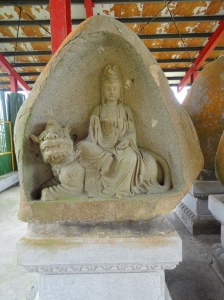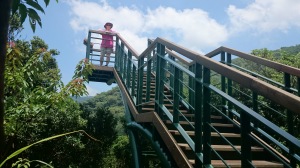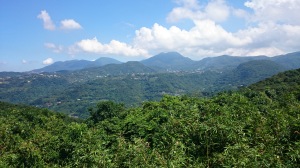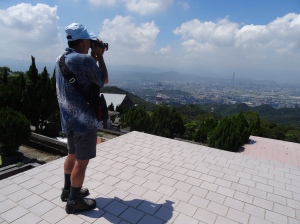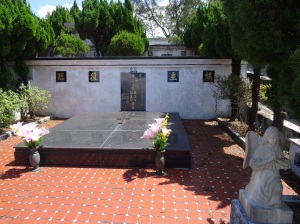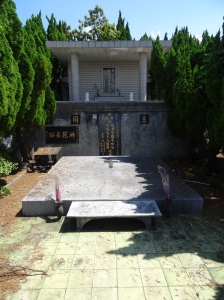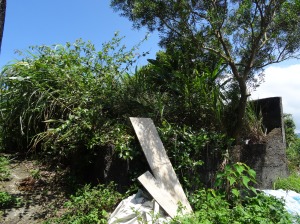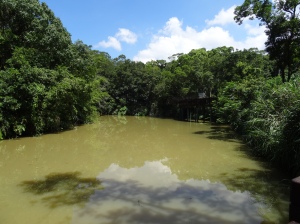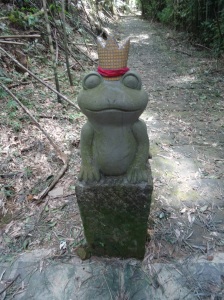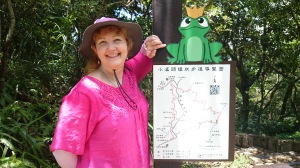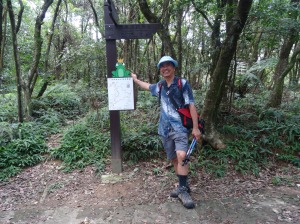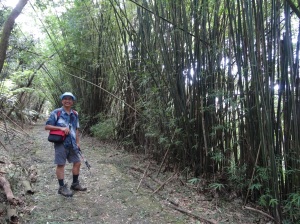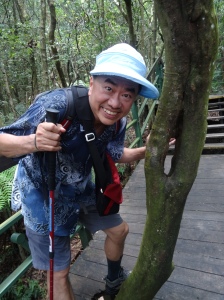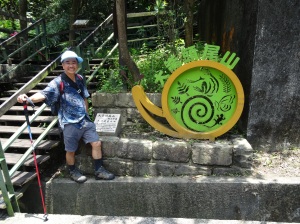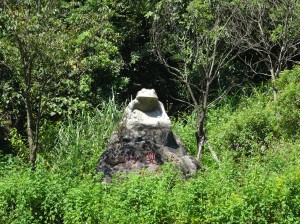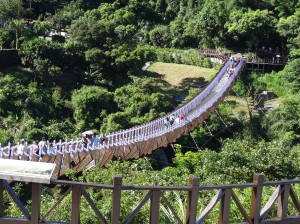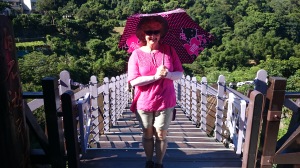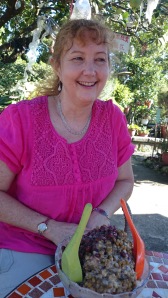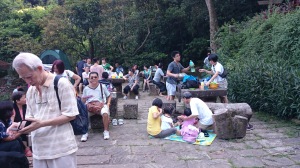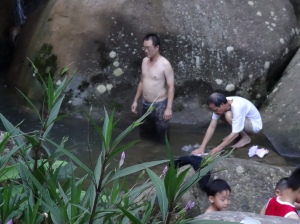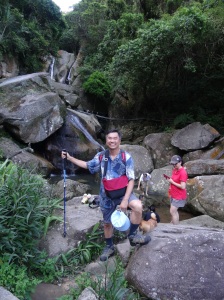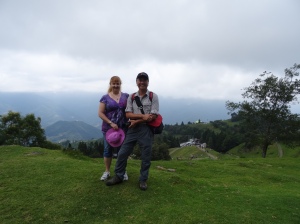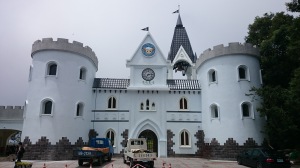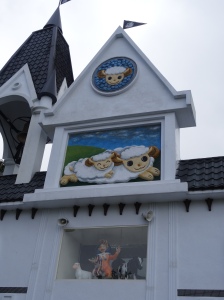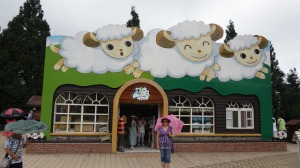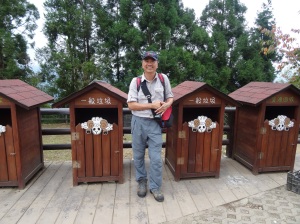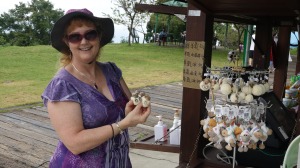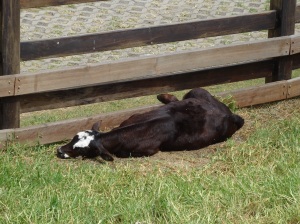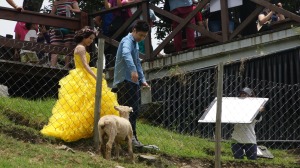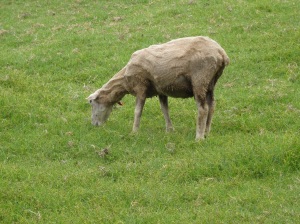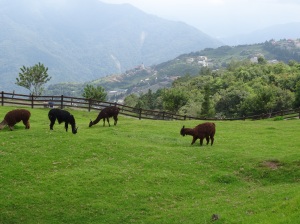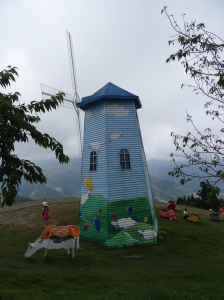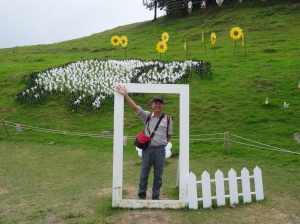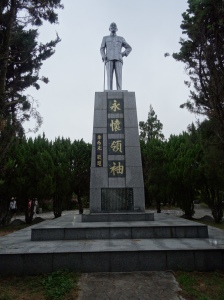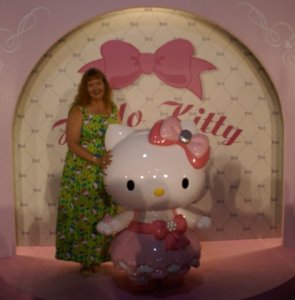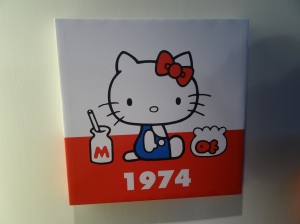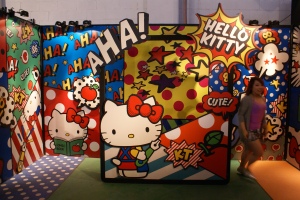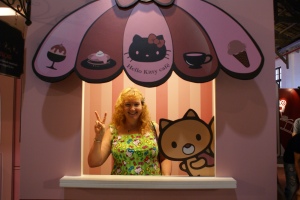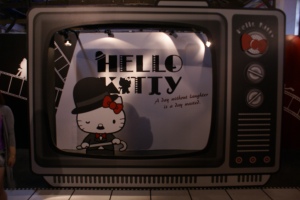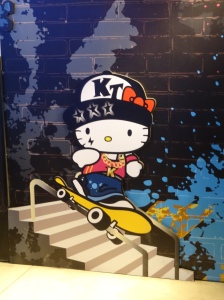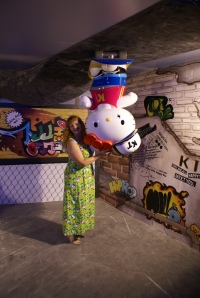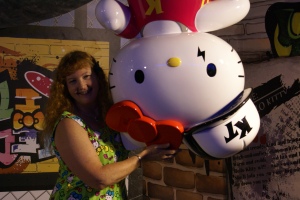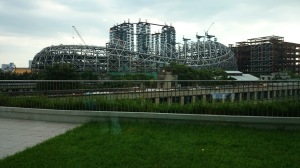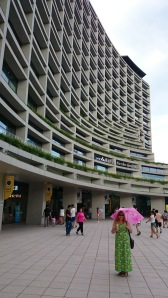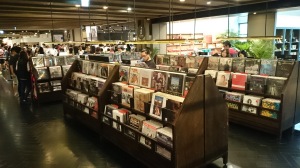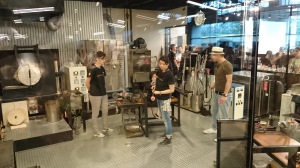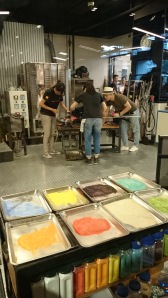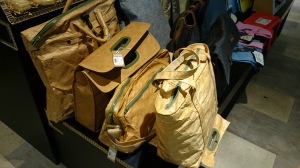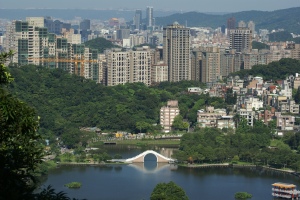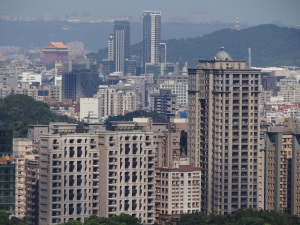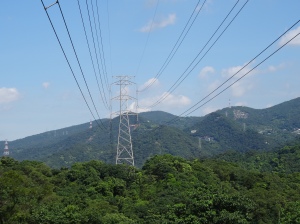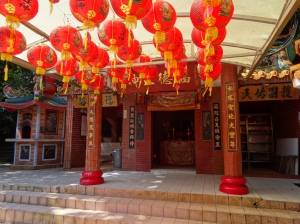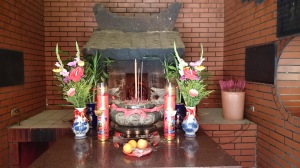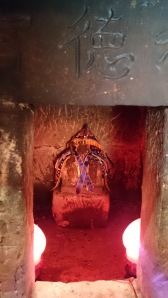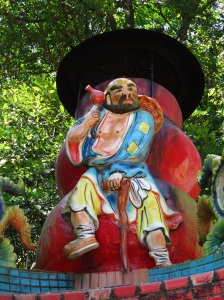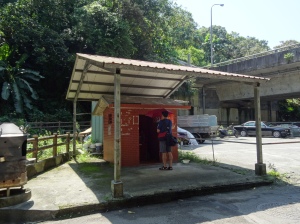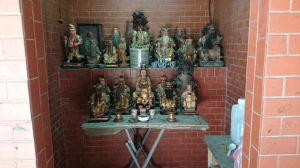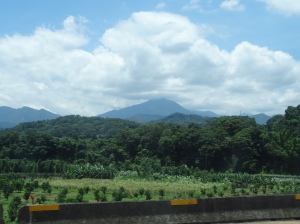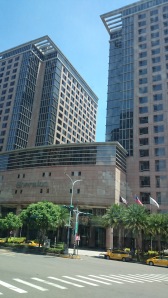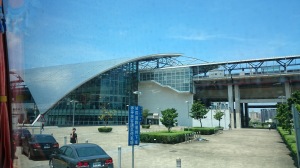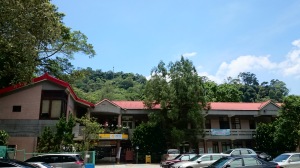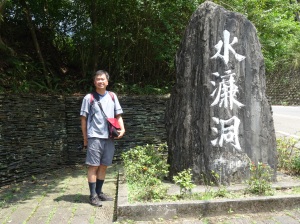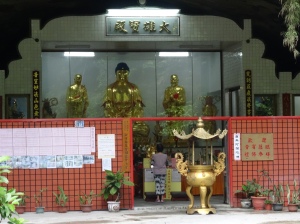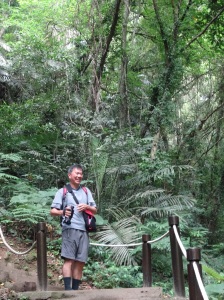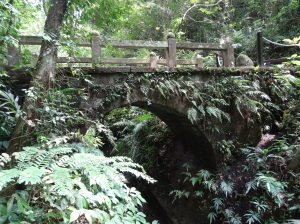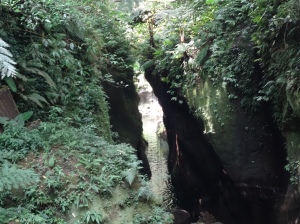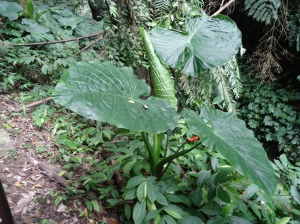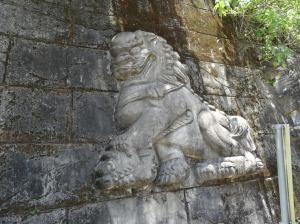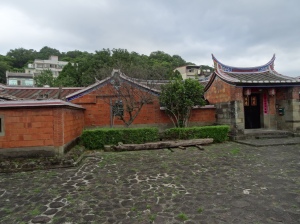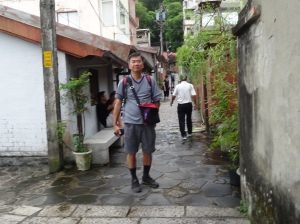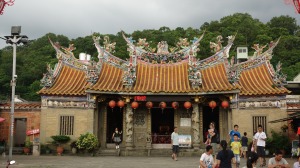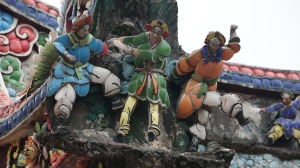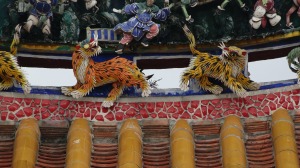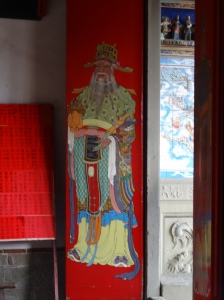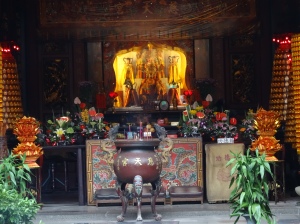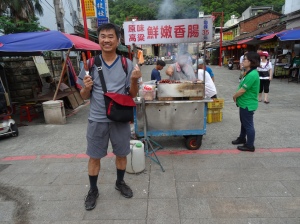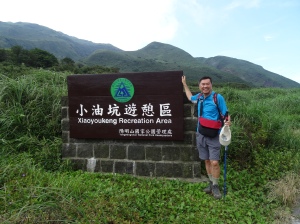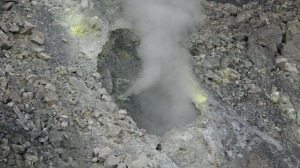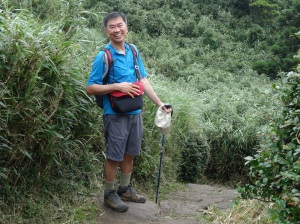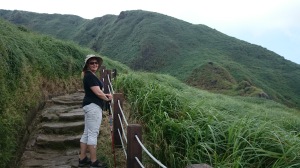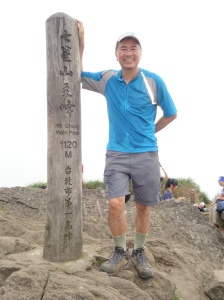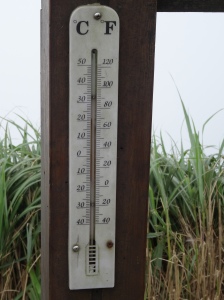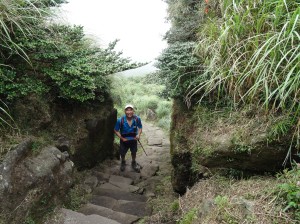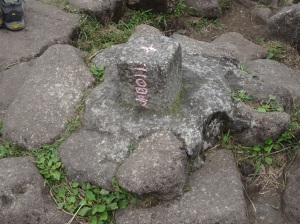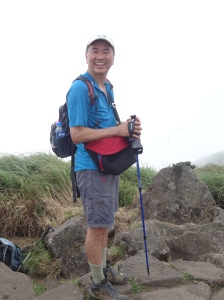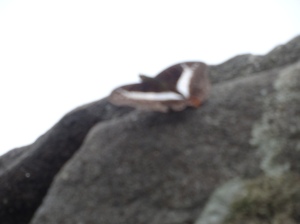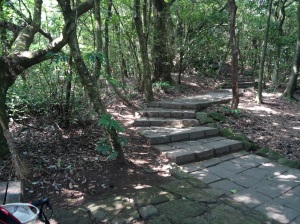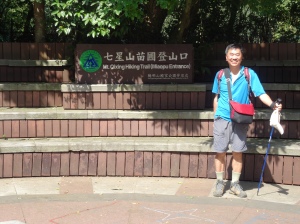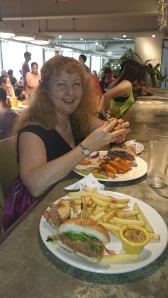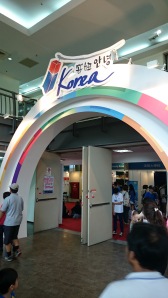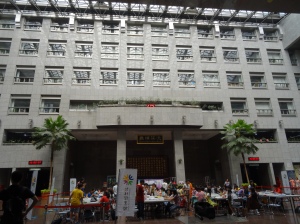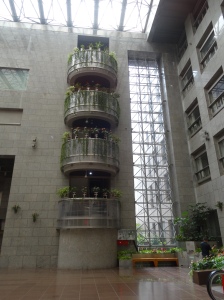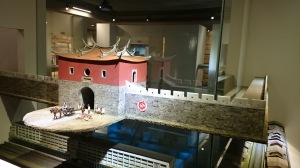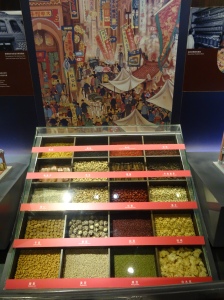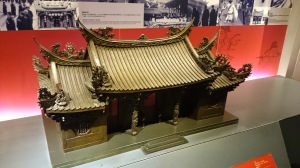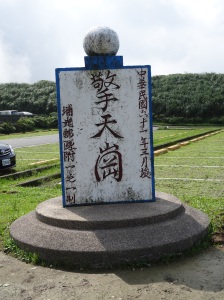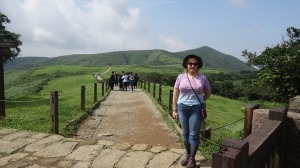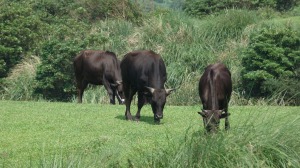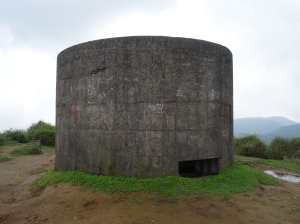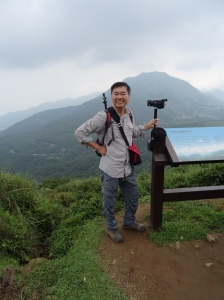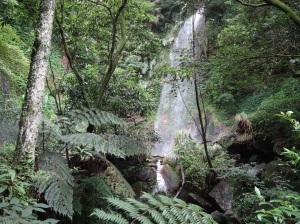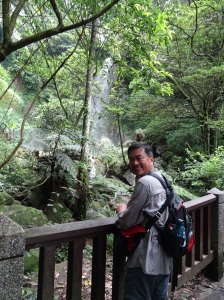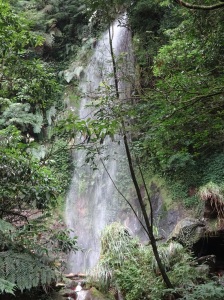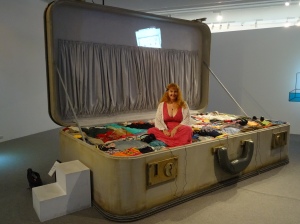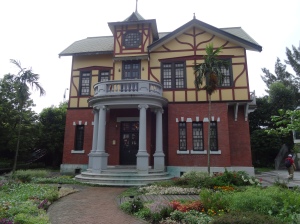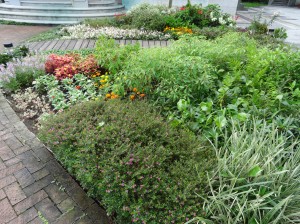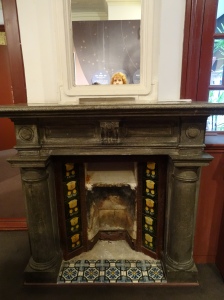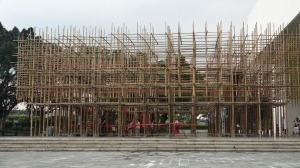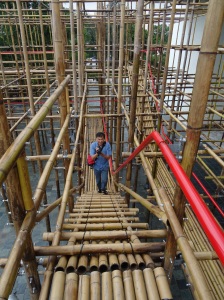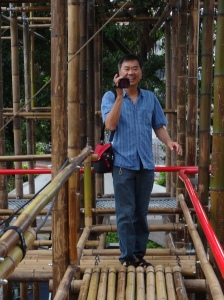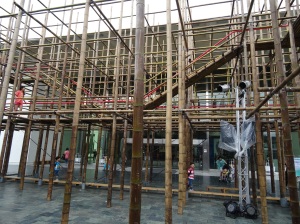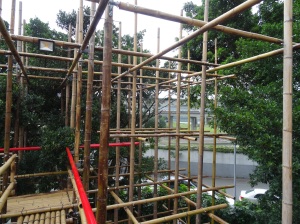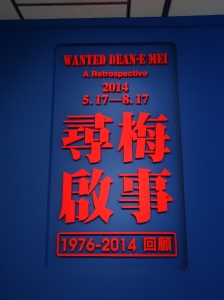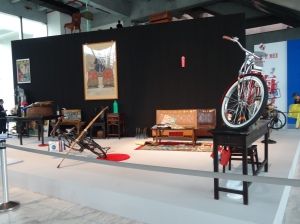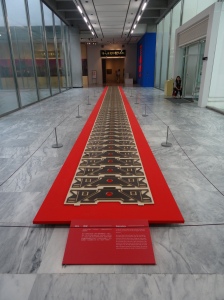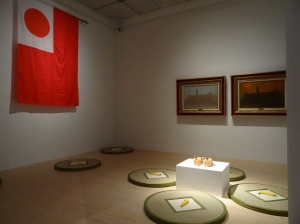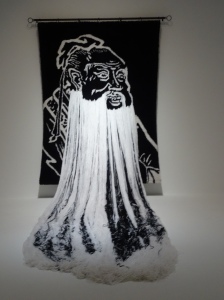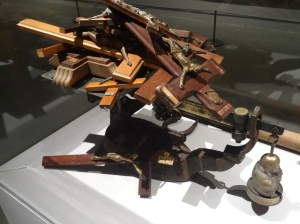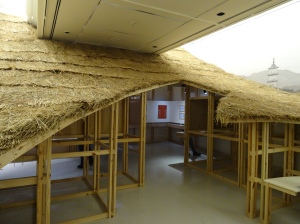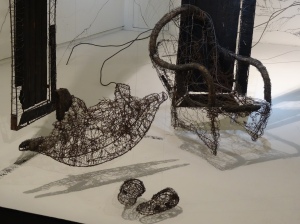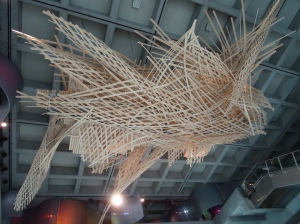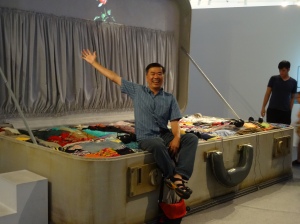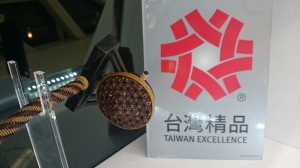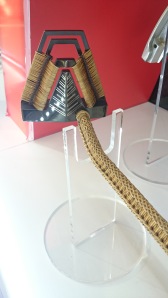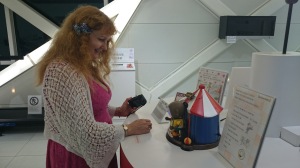This blog entry is out of chronological order, because I forgot an outing when I was writing about our June activities. I have a weak excuse in that these photos did not appear in chronological order in Picasso on my computer. Still, I should have wondered why there was a missing weekend when I was writing about June. We do usually go somewhere every weekend! And on this particular weekend, we went to visit the Nangang Tea Center up in the Nangang mountains northeast of Taipei.
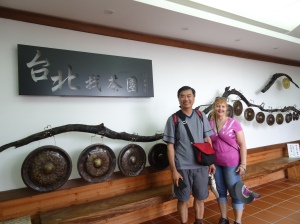
Jeff and Ann are standing in front of a wall displaying different size gongs inside of the Nangang Tea Center
We took the subway to the Nangang station where we were going to catch a bus up to the Nangang Tea Center. But when we arrived at the bus stop, we found out that we had just missed the bus, and another one would not arrive for an hour. So we took a taxi up the winding mountain road to the Nangang Tea Center. Jeff actually told the taxi driver to go past the Tea Center parking lot and continue on the road until it reached the top of the mountain, so we could take photos from there and then walk down to the Tea Center.

Memorial to commemorate those killed in an uprising against Chiang Kai-shek
The first thing that we stopped and checked out was a very large structure near the top of the mountain. It was a Memorial to commemorate the people from the Nangang area who were killed in an uprising against Chiang Kai-shek.
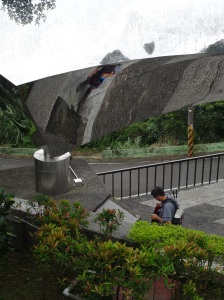
Jeff is reading the plaque on the memorial
Jeff spent some time reading the plaque on the memorial, and then he tried to explain it to me, as there was no English version. I am sorry that I do not remember most of what he told me, except that many people were killed here by Chiang’s army, and some of them were innocent villagers. I have included a photo of the plaque below, so that if you are one of the people reading this blog who can read Chinese characters, you can maybe get a better understanding of the significance of this memorial.

Plaque explaining the memorial
The view of the surrounding mountains from the memorial was beautiful!
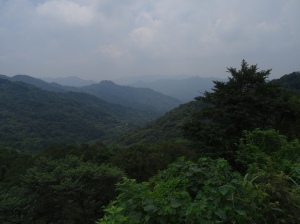
Photo of the mountains of Nangang, taken from the road by the memorial
This statue of a man “coming home to Nangang” was alongside the road up to the Tea House in three different spots. Jeff really liked it, so I am giving it a spot in my blog.

Statue of a man “coming home” to Nangang that was alongside of the road up to the tea center and temple
The Memorial was not quite at the very top of the mountain. We continued walking up the road until it ended at a temple on the top of the mountain. You could not see the temple until you got up close to it, as it was surrounded by large trees.
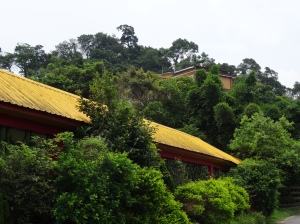
Guangming Temple at the top of the mountain in Nangang
There was a pavillion across the street from the temple. It held six impressive sculptures on pedestals (three on each side) carved out of large rocks.

Pavillion with rock sculptures across the street from the Guangming Temple entrance
The photo below shows a close up of one of the sculptures.
There was also a great view of the mountains from the patio behind this pavillion
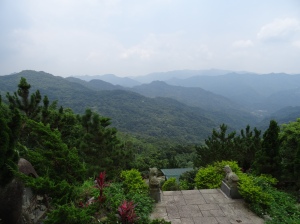
Photo of the Nangang mountains taken from the patio in back of the Guangming Temple pavillion
The entrance to Guangming Temple was not very impressive, at least not in comparison to many that I have seen here in Taiwan or China.
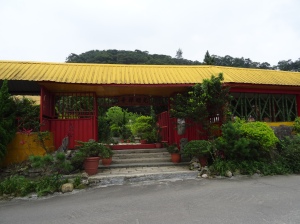
Entrance to Guangming Temple
But that was maybe because you passed through the entrance into a beautiful garden courtyard with a pond.
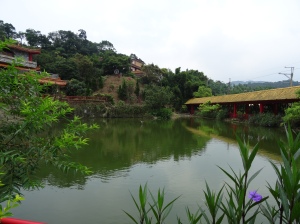
Photo of the pond inside of the courtyard garden of the Guangming Temple
We spent some time walking around enjoying the garden, as we were the only ones visiting the temple at this time.
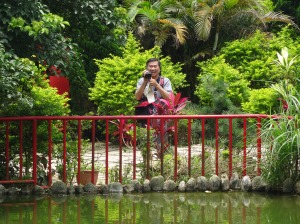
Jeff is taking video in the courtyard garden of the Guangming Temple
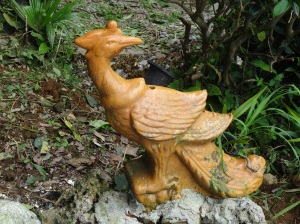
Bird statue near the pond in the Guangming Temple courtyard garden
The Guangming Temple had both a pagoda tower and a main temple building.

Photo of the pagoda tower at the Guangming Temple
Once again, the main temple was very nice, but not as big or impressive as many that I have seen in Taiwan. But it was on a very old site. When I was walking around the courtyard, I spotted several remnants of old stone foundations. So I suspect that there has been a temple here for perhaps hundreds of years.
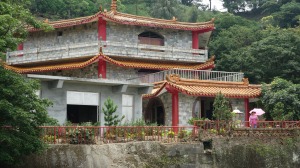
Photo of the Guangming Temple in Nangang
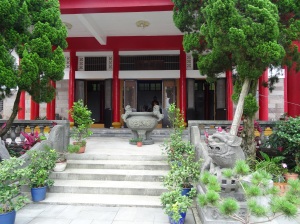
Entrance to one of the halls of Guangming Temple
I wish that I could write more about this temple, but there were no English signs or pamphlets, and there was no one around to ask.
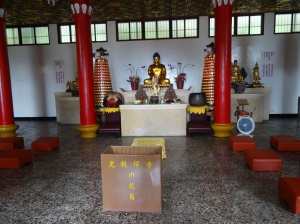
Photo of the inside of the hall of Guangming Temple
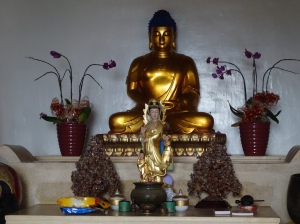
Close up photo of the statue inside this hall of Guangming Temple
I could see the wall of a much older building behind the statue in this hall.

Close up photo of a statue inside of a hall in Guangming Temple
After visiting the Guangming Temple, we walked back down the road to the Nangang Tea Center. We decided to eat lunch at the Tea Center restaurant before visiting the Tea Center. Lunch was delicious, and we got to taste local dishes made with the baozhong tea and sweet osmanthus mix that is the special tea grown by the Nangang area tea farms.
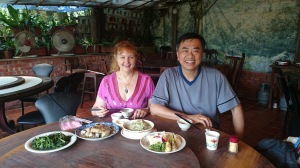
Ann and Jeff in the Nangang Tea Center restaurant
The department of economic development of Taipei opened the Nangang Tea Processing and Demonstration Center in 1991 to maintain and enhance the standards of Nangang baozhong tea production,.The Tea Center includes a display area, a tea sampling area, a restaurant, and landscaped grounds with a pond. The display area includes information regarding the tea manufacturing process, the proper way to brew tea and the way to store tea.

Photo taken looking down from the patio in front of the Nangang Tea Center

Close up photo of the ducks in the previous photo
The representative tea of the Nangang District is the baozhong tea. 150 years ago, a Fujian man, Xi Cheng Wang, produced baozhong tea using the Wuyiyan production method. The Nangang baozhong tea is a half fermented, oolong style tea. .The tea is often blended with the osmanthus flowers that are also grown in this area. giving it a pleasant fragrance.

Wagon used to transport baskets of harvested tea leaves
We spent some time walking around the grounds outside of the Tea Center. There was a pair of large gongs hanging in a patio outside ofthe center.

Jeff is standing next to a large gong hanging in a patio outside of the Nangang Tea Center
The tea consumed by the Taiwanese was first imported from mainland China—primarily from the provinces of southern Jiangsu and Fujian—during the Ming and Qing dynasties. Local Taiwan teas were produced mainly for export purposes, and it was not until the 1970s that the tea market slowly began to meet local demand.

Rock art in the patio outside of the Nangang Tea Center
Local Taiwan teas originated from plants growing in the wild. Taiwan teas held little commercial value at first, but this changed after breeding improvements were made to the tea plants, making them suitable for making black tea. After the Treaties of Tianjin were ratified in 1860 and the port of Danshui was opened for trade, British tea merchant John Dodd began working with tea merchants and farmers to promote Taiwan tea, slowly developing it as an export item. Before long, tea ranked first among Taiwan’s top-three exports, ahead of sugar and camphor.

Front entrance to the Nangang Tea Center
The earliest teas exported during the Qing dynasty were oolong and baozhong tea, which began to be sold abroad in 1865 and 1881, respectively. In 1906, during the Japanese occupation, black tea began to be exported alongside oolong and baozhong tea.
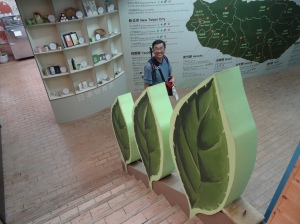
Jeff is standing inside the display center of the Nangang Tea Center
The center also provides information concerning the history and distribution of Taiwanese teas.There was also a tea processing factory attached to the Nangang Tea Center.

A stack of drying trays for tea leaves inside of the tea processing factory
The factory was officially opened in 2002. There are various types of tea processing equipment on display inside of the factory area, but no one is demonstrating how they are used. In this way, it is similar to the Maokong Tea Center in southwest Taipei.
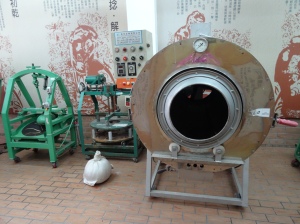
Tea processing equipment inside of the factory at the Nangang Tea Processing Center
In 1949, Taiwan also began exporting green teas. These included fried green teas, such as zhu tea and mei tea. In 1963, steamed green tea, or Sen tea, began to be exported to Japan, and by 1973, the largest exported tea product was Sen tea.
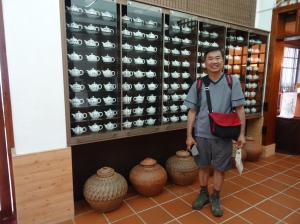
Jeff is standing next to a display of teapots inside of the Nangang Tea Center
In 1973, Taiwan’s tea producers began to realize the importance of the domestic market. Through the collaboration of county governments in tea-producing areas, farmers’ associations, and the mass media, a foundation was created for promoting tea in the domestic market. On August 14, 1977, the Chinese Kung Fu Tea House, the first of Taiwan’s modern teahouses, was established. Before long, teahouses were sprouting up everywhere, and these local teahouses slowly organized into associations devoted to the promotion of tea culture.
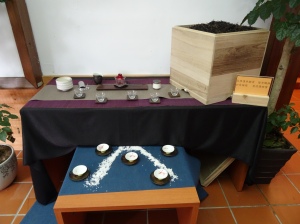
Tea serving area inside of the Nangang Tea Center
There are two tea harvests in Nangang, in the late fall and spring. We were visiting in June, and it was hot, so that likely explained why there were so few people here! After we left the Nangang Tea Center, we walked around the trail that circles the center. The trail had many trees, and thus it was shady and cool.
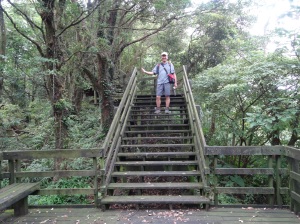
Jeff is standing on wooden steps that are part of the trail circling the Nangang Tea Center
There was a cute little bridge across a creek on this trail. It had two stone teapots next to its entrance.

Jeff is standing next to a stone teapot near the entrance to the bridge
It was an interesting outing, and I learned a lot about tea from reading the English displays inside the Nangang Tea Center. Maybe if we return during the tea harvest in November, I can find out more about the Guangming Temple and the Memorial.

